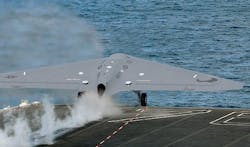Navy leaders expected to make a decision on carrier unmanned refueling tanker this month
NATIONAL HARBOR, Md. – Top officials of Lockheed Martin Corp. say their candidate for the Navy’s MQ-25 Stingray carrier-capable unmanned refueling tanker is a flying wing that meets or exceeds all the Navy’s requirements.
The Lockheed Martin Skunk Works segment in Palmdale, Calif., developed the Air Force’s first stealthy jet fighter, the bat-winged F-117 Nighthawk that starred in the first Gulf War.
The company’s candidate for the MQ-25 is a “clean sheet, purpose-driven” design that incorporates many low-risk features to support the Navy’s F-35C Lightening and F/A-18 Super Hornet fighters in aerial refueling operations at sea, says Rob Weiss, Skunk Works vice president and general manager.
Weiss made his comments earlier this spring at the Navy League Sea-Air-Space conference and trade show in National Harbor, Md. The General Atomics Aeronautical Systems segment in Poway, Calif., and the Boeing Co. Defense, Space & Security segment in St. Louis also are competing for the MQ-25. Navy leaders say they plan an award this month.
The Lockheed Martin MQ-25 design leverages the design of the unmanned carrier-launched airborne surveillance and strike (UCLASS) platform, which the Navy decided in early 2016 to retool as a long-range tanker for carrier-based fighters.
Related: Boeing unveils unmanned carrier airborne tanker prototype aircraft inspired by a stingray
The MQ-25 must be able to carry 14,000 pounds of fuel and refuel aircraft from as far away as 500 miles from the carrier.
Weiss says that Skunk Works conducted trade studies and looked at more conventional designs, but the flying wing proved out in terms of fuel capacity and efficiency, use of current systems and technologies, and operating with manned aircraft.
“Everything we’ve done is aimed at low-risk,” he says. “The flying wing is the right size for delivering fuel to the fighters at top speed, thereby extending their strike ranges.”
The Triumph Group Aerospace Structures segment in Berwyn, Pa., built the Skunk Works MQ-25 internal airframe. The tanker uses United Technologies landing gear and is powered by a General Electric F404 engine -- the same engine used by the F/A-18. The engine has more than 13 million hours of flight time. The tanker will use the Raytheon-developed joint precision approach landing system (JPALS).
The aircraft will be capable of operating alongside the F-35C and F/A-18. Airflow is benign, minimizing turbulence. All fuel is stored in the wing—essentially the aircraft’s entire body.
Weiss says Lockheed Martin has made substantial investments in artificial intelligence and machine learning for the MQ-25 program. The company’s candidate is not low-observable because that isn’t a Navy requirement. It could, however, be modified for low-observability if that were necessary. Hard points that carry fuel tanks also could carry weapons like the joint standoff weapon (JSOW), if required.
General Atomics recently announced its MQ-25 team: Boeing Aerostructures for autonomous vehicle experience; L3 Technologies, communications; United Technologies, landing gear; BAE Systems for mission software; Rockwell Collins for navigation technologies and networked communications; and GKN Fokker for the tailhook. The aircraft will use Pratt & Whitney’s PW815 engine.
Boeing’s candidate, called the T-1, has been developed by the company’s Phantom Works. It says its MQ-25 benefits from “more than 90 years of carrier aircraft experience” and meets all refueling requirements “by a substantial margin.”
Ready to make a purchase? Search the Military & Aerospace Electronics Buyer's Guide for companies, new products, press releases, and videos
